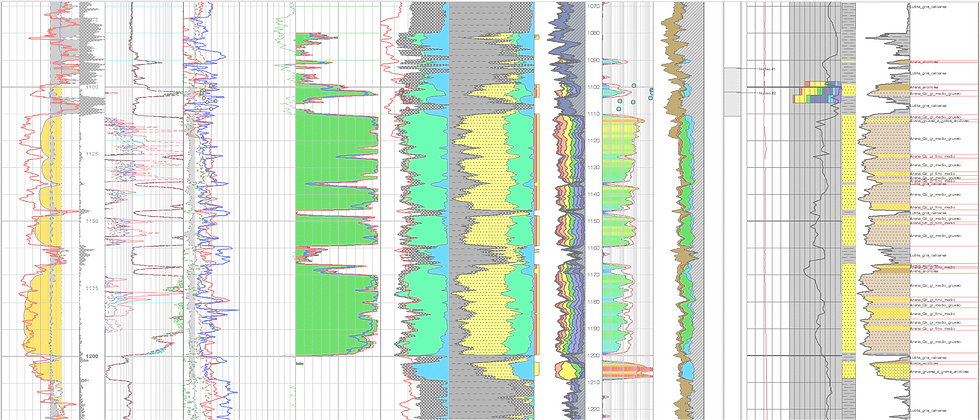
Advanced Petrophysics
Consulting Services
Featured Services
CAYROS group has developed the expertise to help E&P companies better understand their reservoirs, make better decisions faster, and implement customized, innovative workflows combined with an extraordinary set of sophisticated tools and technologies for cost-effective formation evaluation and advanced petrophysical services.
Depending on the complexity of the reservoirs and final goals of our clients, we customize our workflow to your needs. Whether it’s applying deterministic and probabilistic techniques in complex mineralogy shaly sands, carbonates, tight reservoirs, shale gas, shale oil, CBM, fractured reservoirs or something else, we have the experience you need to succeed.
Unconventional and organic rich reservoirs
Over the past decade, CAYROS has built a significant expertise in the characterization of unconventional resources.
Organic matter characterization, maturity, adsorption, intra-TOC porosity, porosity, HC saturation, mineralogy, chemostratigraphy, permeability, mechanical and seismic rock properties are evaluated using all the available data from core, cuttings, logs, drilling parameters, etc.


Fractured carbonates
Complex porosity architectures and mineralogy, combined with natural fractures make the characterization of these reservoirs a challenging task.
Our experienced petrophysicists have work in some of the largest fractured carbonates fields in the world.
Oil sands
Canadian Oil Sands can be very complex with rapid lateral and vertical variations in both facies and fluids. Some of the challenges in their characterization include: Facies variation, formation water salinity variation, Top water, Gas, Lean zones, etc.
SAGD technology is used to produce these formations, and it relies on steam chamber growth within the reservoir, which is affected by the variability in the fluid and rock properties.

Low resistivity / low contrast reservoirs
Reservoirs with very complex lithology, especially high content of structural clay, as well as high salinity of formation water affect the log readings, causing these formations to show high radioactivity and low resistivity, which in turn, makes their identification and evaluation difficult. In other cases, is the presence of metallic minerals that affect log readings.


Multimineral models for complex lithology
Deterministic petrophysical workflows have been applied successfully for decades in many reservoirs. Applying these workflows in formations with complex mineralogy has been challenging because traditional models / concepts are not always applicable. Multimineral probabilistic models offer an alternative to overcome these problems in reservoirs with complex lithology.
Cased-hole well log analysis
CAYROS has developed an in-house user program in two different platforms for the analysis and interpretation of pulsed neutron logging (PNL) tools to help our client monitoring steam chamber growth, sweep efficiencies, and residual oil saturations as part of their reservoir surveillance program for Oil Sands reservoirs. Our solution seamlessly integrates open-hole baseline interpretation.


Permeability and Secondary Porosity modelling
We use several techniques to build working permeability-predicting models. When available we combine core / drilling cuttings measurements with log measurements to calibrate prediction.
We also characterize secondary porosity and permeability in naturally fractured reservoirs by integrating not only all the static available data, but also dynamic measurements.
Saturation Height Modelling
In addition to commercial tools, we developed a proprietary software for capillary pressure data correction, validation and analysis. It allows to perform conformance corrections, conversions, rock typing, saturation height modelling and permeability calculation from Pc.
Our saturation height modelling can be based on capillary pressure data (when available) or theoretical models using log interpretation.


Rock Typing | Petrofacies | Lithotypes | Flow units
By integrating geological data, core and drilling cutting measurements and descriptions with log data, we use different techniques to define rock types / petrofacies /flow units that allow us to better predict permeability and other properties. We correlate results to seismic facies to populate geocellular models.
Geomechanics & Seismic rock properties
Compressional / shear sonic and density logs are used to calculate elastic properties: Poisson’s ratio, Young’s modulus, bulk modulus, shear modulus, vertical Biot’s factor. (Core calibrated if available).
As part of our workflow we compute brittleness, rock strength (UCS), HV stress, SH min and seismic rock properties like Acoustic Impedance, VpVs, and LMR.


Core Photo / Image log Special Processing
We have developed a tool for obtaining quantitative data from images. Our Computer Vision Technique (CVT) generates an image-based new set of logs (intensity and morphology) that can be used for quantifying Net to gross in heterolithic deposits, definition of fluid contacts, facies prediction, rock typing, and accurate core depth matching
Horizontal Well Re-steering Interpretation
Resteering interpretation to accurate position horizontal wells within a reservoir to better understand well productivity, assess the geology or drilling parameters, generate synthetic logs, properly include well in a 3D geological or simulation model.


Advanced Formation Water Characterization
Formation water is usually considered an undesirable by product of Hydrocarbon production. However, analysis of that same water can provide critical information for the reservoir characterization and field development plan. For example, connate water salinity and divalents are critical to chemical EOR processes for both surfactants and polymers.
Depending on the project objectives, available data, type of reservoirs and other criteria, we offer customized workflows in conventional and unconventional reservoirs to meet and exceed our clients’ expectations.
We help our clients design the correct project and workflow for their assets, and we firmly understand that integrating and honouring all the available data and disciplines is critical.
We are experts in validating, correcting, and integrating core analysis data. This is critical, because in many reservoirs (especially unconventional ones) complex mineralogy and organic content results in variable matrix density, which can compromise log porosity estimates. In addition, matrix permeability calculations, log-based rock mechanical properties, and hydrocarbon saturation calculations can be highly inaccurate unless calibrated with core data.

